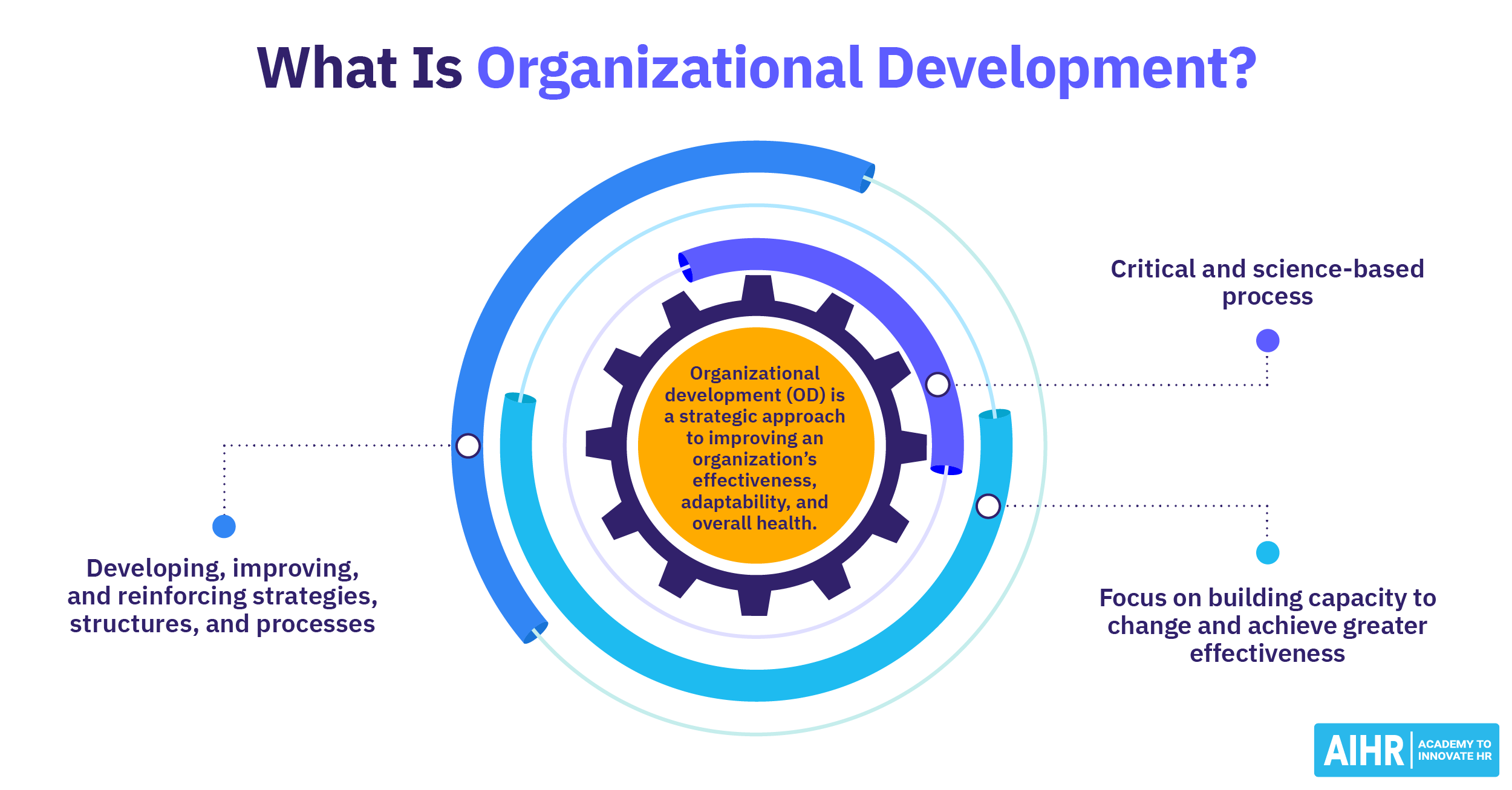Divisional Structure
What is a divisional structure?
A divisional structure is a common organizational framework that groups business activities based on products, services, geographical locations, or markets. Each division within this structure operates as a semi-autonomous entity equipped with its own set of resources and functions.
The purpose of a divisional organizational structure is to provide a targeted focus on specific products, regions, or markets, thereby increasing efficiency and agility. Companies with wide product ranges and operations in many different markets often choose this organizational framework. Some leading divisional organizational structures include:
- The Walt Disney Company: The famous entertainment conglomerate uses a divisional organizational structure centered around its different business segments, such as Walt Disney Parks, Experiences and Consumer Products and Walt Disney Studios. This structure allows Disney to effectively manage its diverse operations across various industries like entertainment, media, and theme parks.
- McDonald’s Corporation: The fast food giant employs a divisional structure primarily based on geographical regions, including the U.S. and international markets. This approach allows McDonald’s to adapt its operations and marketing to the unique needs of different local markets while maintaining a consistent global brand.
Organizational structures play a crucial role in business success. To learn more about developing and optimizing your organization’s structure, download our Organizational Development Process Cheat Sheet and gain insights into effective OD strategies.
Key characteristics of a divisional structure
Here are some common characteristics of a divisional organizational structure:
- Autonomy within divisions: Each division typically operates as its own entity with its own set of financial resources, management structure, and performance targets. It has the autonomy to make decisions based on the needs of its specific market or product areas.
- Product or market focus: There’s a specific organization around products, services, or markets. This level of specialization allows each division to tailor approaches and strategies to a particular customer base and market.
- Responsibility over profit and loss: Organizational divisions are often held accountable for their financial performance, giving them the incentive to drive business growth and profitability.
- Team expertise: Each division comprises teams with specific skills, backgrounds, and expertise around their particular focus area.
- Robust performance measurement: Each division is regularly evaluated on its performance with detailed metrics to track goals and targets. Measurement systems ensure that the right level of resource allocation to different divisions.
Divisional structure example
Tree of Life, a global plant-based company, is a thriving example of a divisional organizational structure. With product-based divisions tailored to diverse markets in Europe, North America, and Asia, the company has outpaced competitors because of its agile and adaptable structure. As a result, it’s been able to successfully localize its product range of almond, coconut, rice, and mung bean drinks.
Its divisional structure looks like this:
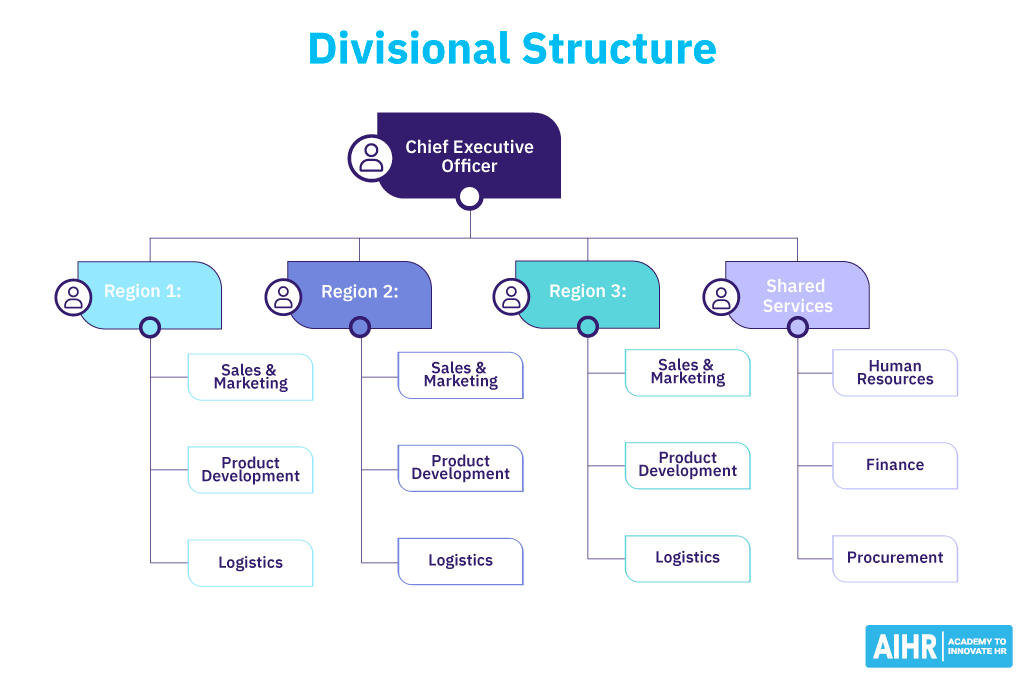
Functional vs. divisional structure
Focus
An organizational structure grouped by product, service, market, or geographic region.
A structure organized by job function or activities such as marketing, finance, communications, and IT.
Hierarchy
Decentralized hierarchical structure, with divisional managers.
Clear and established hierarchy.
Authority and control
By divisional management.
By the top management of each function.
Communication
Horizontal channels across divisions.
Vertical channels within each function.
Adaptability
Agile and responsive to changes in the market.
Slower to adapt to market shifts and changes.
Suitability
Most suitable for companies with diverse products and services and flexible environments.
Best for companies with standardized products and services and stable environments.
Divisional structure advantages and disadvantages
The advantages
- Flexibility and adaptability: Divisions can respond more quickly to market changes. Since they enjoy a high degree of autonomy, they can make swift decisions without bureaucratic processes slowing them down.
- Greater innovation: Individual divisional structures have the freedom to experiment, test new ideas, drive product innovation, and tailor solutions to specific markets and customers.
- Increased transparency: On a corporate level, it’s easier to have greater insight into individual divisional structures. This high-level overview enables a company to understand how well a division performs, identifying strengths and weaknesses to make more informed organizational decisions.
- Improved risk management: A company can have greater control over risks and losses when they are contained within individual divisions. This has the potential to lower the impact on the overall business.
- Targeted talent attraction and retention: Since divisional structures require a unique set of skills and capabilities, HR can focus on tailored talent acquisition and retention strategies. This allows for targeted skill development, training, and career advancement activities to attract and retain highly skilled talent.
The disadvantages
- Limited cross-functional collaboration: There is a risk of working in isolation, as well as limited communication across divisions. This siloed approach can affect knowledge sharing, innovation, and implementing best practices across the organization.
- Duplication of resources: Typically, each division has its own administrative functions – such as sales, finance, and marketing – which can lead to inefficient use of resources and increased costs.
- Challenges in maintaining a consistent company culture: It may be harder to create a unified company culture when there are different divisions, especially those spread across multiple regions. As a result, it can negatively impact the sense of a shared culture and values across the organization.
- Unhealthy competition: The funding for resources among divisions can be quite competitive, which can cause conflicts and low morale. It’s important not to let these conflicts affect the overall performance of individual divisions.
- Limited talent mobility: Although targeted talent attraction and retention have benefits within divisional structures, they can limit talent mobility across the organization. Employees may find it challenging to expand their careers outside their specific divisions, limiting their career advancement opportunities.
4 other types of organizational structures
1. Functional organizational structure
A functional organizational structure comprises several departments based on specific skills and areas of expertise.
- Benefits: Grouping employees based on their function leads to a high level of expertise in specific areas by. The reporting lines are also clear.
- Limitations: Slow response times due to centralized decision making, and limited view of organizational goals due to departments being focused on their own objectives.
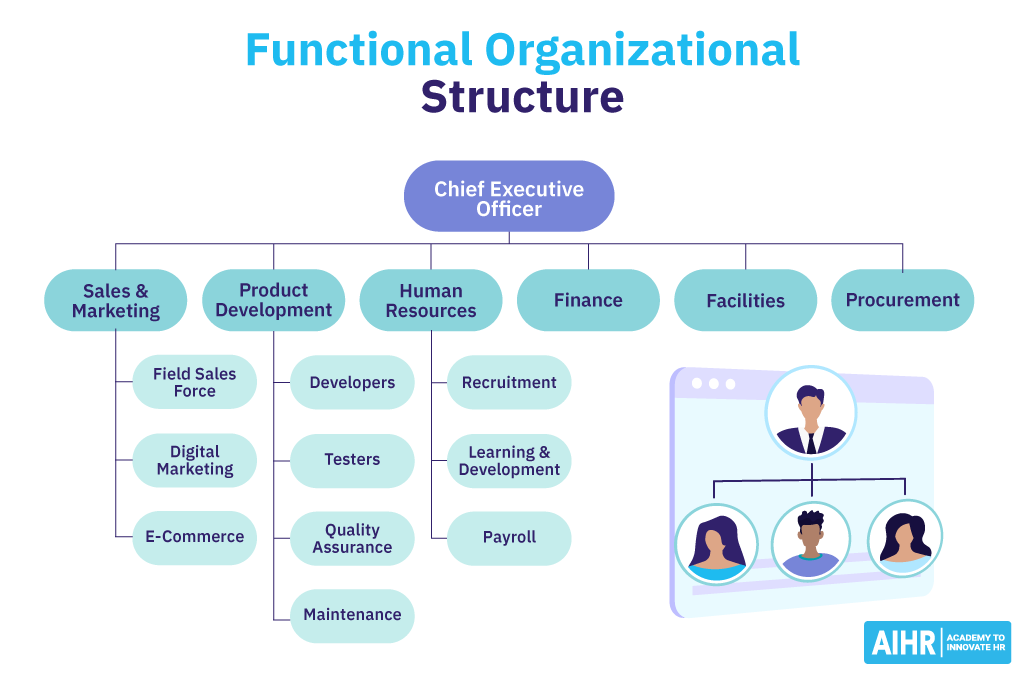
Companies that use this structure: Amazon, Apple
2. Matrix structure
A matrix structure combines elements of both a functional structure and divisional structure. Employees report to two bosses: one for their functional area (like marketing or finance) and one for their product or project.
- Benefits: Drives cross-disciplinary collaboration, shared expertise across the organization, and innovation.
- Limitations: Often internally focused and requires clear governance to work. Internal tensions in terms of conflicting priorities and accountability may arise.
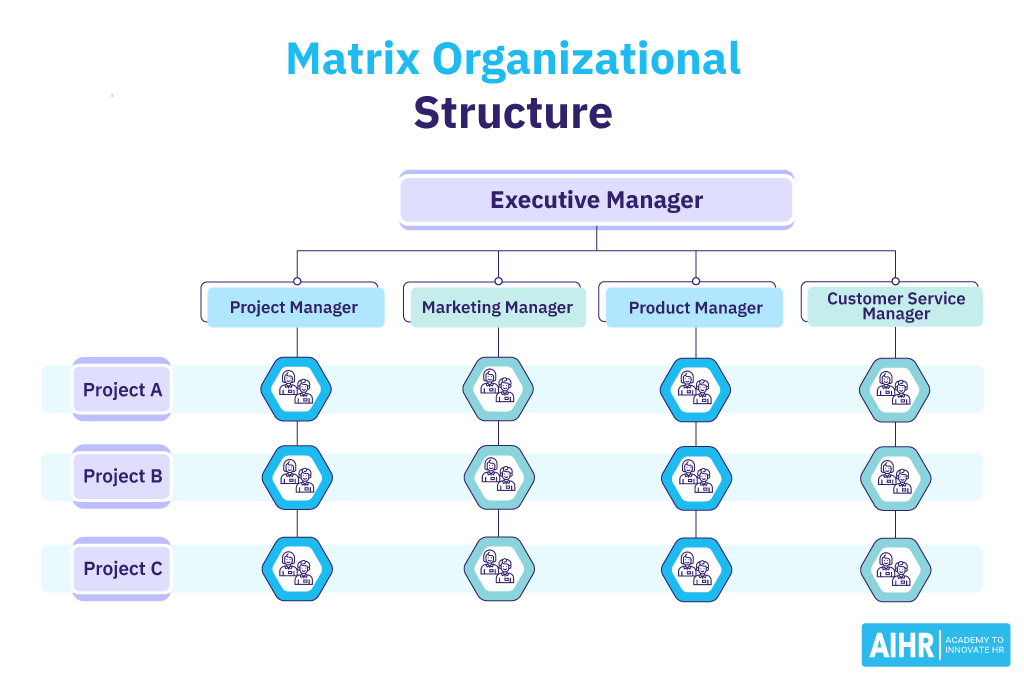
Companies that use this structure: Nike, Phillips
3. Flat organizational structure
A flat organizational structure has few or no levels of middle management between staff and executives. As such, it encourages open communication and collaboration.
- Benefits: Drives ownership and accountability, makes collaboration easier.
- Limitations: Often struggles to differentiate between strategic and operational work. Resource allocation can also be too thinly spread across different areas. Additionally, the need to seek consensus from multiple parties could slow down decision-making.
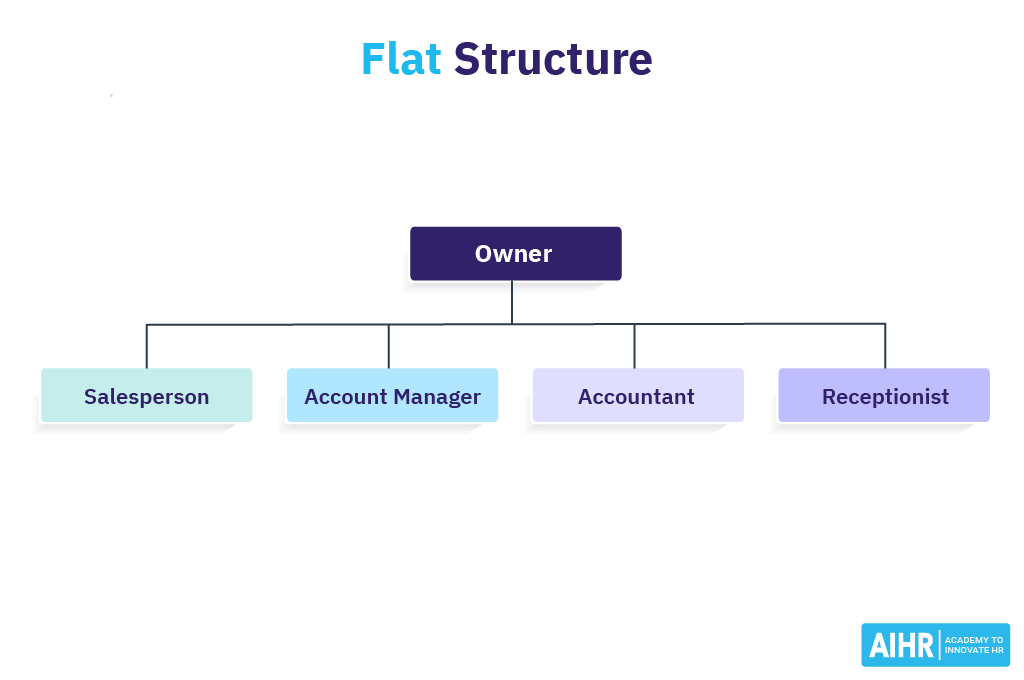
Companies that use this structure: Valve, Buffer
4. Team-based or agile structure
This structure is organized by project teams that often function autonomously, working towards specific goals.
- Benefits: Leverages cross-functional capacity, more flexible in resource allocation.
- Limitations: Decision-making and resource allocation are not always clear, which can result in fragmented work practices and a lack of consistency.
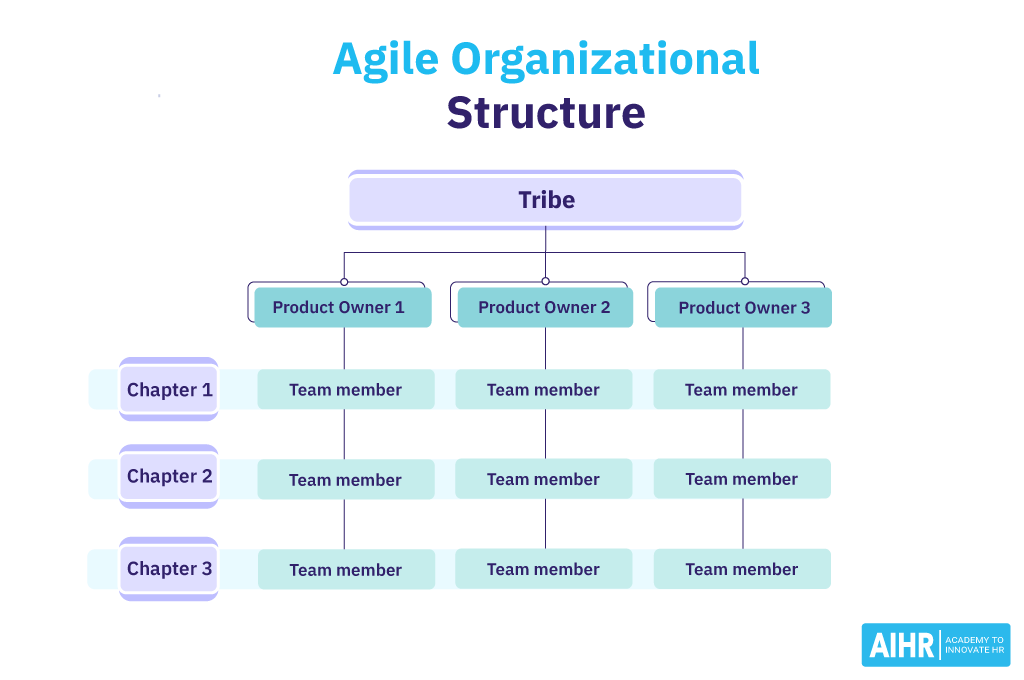
Companies that use this structure: Spotify, Airbnb
FAQ
A divisional structure is ideal for large companies with an extensive range of products and services or operations in multiple locations, regions, or markets. This organizational structure allows them to tailor strategies and resources within each division, such as product development for specific customer segments or markets.
A functional structure organizes employees based on their specialized roles, such as marketing, finance, or HR. This approach fosters deep expertise within each function but can lead to silos, where departments may operate independently with limited cross-functional collaboration. In contrast, a divisional structure groups employees based on specific products, services, or geographic locations. Each division operates semi-independently with its own resources, allowing for greater flexibility and responsiveness to market needs. However, this can result in duplicated efforts and resources across divisions.
McDonald’s uses a divisional structure to effectively manage its vast global operations by dividing the company into regions or product divisions. This structure allows for greater focus on local markets, enables quicker decision-making, and ensures that each division can adapt to regional customer preferences, regulatory requirements, and competitive landscapes.
The four types of organizational structures are functional (operations are divided into specialized units like marketing or finance), divisional (organized around products, markets, or geographies), matrix (combines functional and divisional structures, allowing for dual reporting relationships), and flat (minimal hierarchy and a more flexible, collaborative approach, often used in startups and innovative companies).








